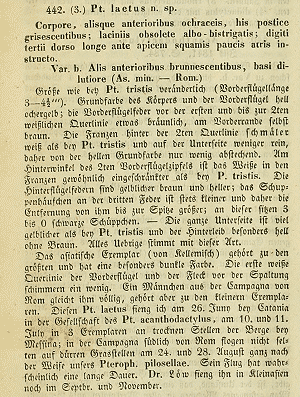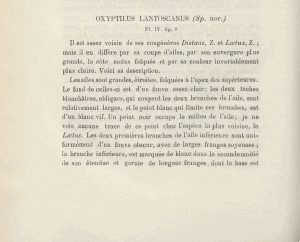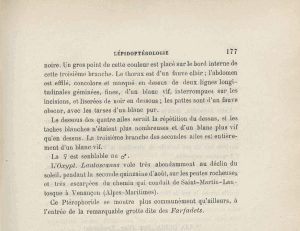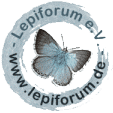Version 22 / 28 vom 28. Mai 2019 um 21:31:50 von Michel Kettner: Strukturanpassung
Länder:

 +22Kontinente:EUAS
+22Kontinente:EUAS


 +22Kontinente:EUAS
+22Kontinente:EUASInhalt
2. Diagnose
2.1. Geschlecht nicht bestimmt
2.2. Erstbeschreibung
1: Zeller (1847: 903) [nach Copyright-freiem Scan auf www.biodiversitylibrary.org]
2.3. Beschreibung als Oxyptilus lantoscanus
1-2: Millière (1882: 176-177) [nach Scans des Göttinger Digitalisierungszentrums [GDZ] mit schriftlicher Genehmigung des GDZ. Besitzerin der Vorlage: Niedersächsische Staats- und Universitätsbibliothek]
Im übernächsten Jahrgang dazu erschienene Abbildung:
1-2: Millière (1884: pl. IV fig. 8) [nach Scan des Göttinger Digitalisierungszentrums [GDZ] mit schriftlicher Genehmigung des GDZ. Besitzerin der Vorlage: Niedersächsische Staats- und Universitätsbibliothek]
3. Weitere Informationen
3.1. Andere Kombinationen
- Crombrugghia laetus (Zeller, 1847) [so in der [Fauna Europaea, last update 29 August 2013, version 2.6.2]]
3.2. Synonyme
- Pterophorus loetidactylus Bruand d'Uzelle, 1859
- Oxyptilus lantoscanus Millière, 1882 [synonymisiert durch Arenberger (2002)]
3.3. Literatur
- Arenberger, E. (2002): Pterophoridae II. Deuterocopinae, Platyptiliinae: Trichoptilini, Oxyptilini, Tetraschalini (= Gaedike, R. [Hrsg.] (2002): Microlepidoptera Palaearctica 11): 1-287, 96 pl. Keltern (Goecke & Evers).
- Beschreibung als Oxyptilus lantoscanus: Millière, P. (1882): Lépidoptérologie. Huitième fascicule. — Annales de la Société linnéenne de Lyon 29: 153-179.
- Millière, P. (1884): [Bildtafeln zum Aufsatz von 1882]. — Annales de la Société linnéenne de Lyon 31: pl. I-IV.
- Erstbeschreibung: Zeller, P. C. (1847): Bemerkungen über die auf einer Reise nach Italien und Sicilien beobachteten Schmetterlingsarten. — Isis von Oken 1847 (2): 121-159, (3) 213-233, (4) 284-308, (6) 401-457, (7) 481-522, (8) 561-594, (9) 641-673, (10) 721-771, (11) 801-859, (12) 881-914.
3.4. Informationen auf anderen Websites (externe Links)
- [Géneros LEPIDOPTERA em Portugal] dort unter Crombrugghia laetus zu finden.
- [Moths and Butterflies of Europe and North Africa] dort unter Crombrugghia laetus zu finden.






























